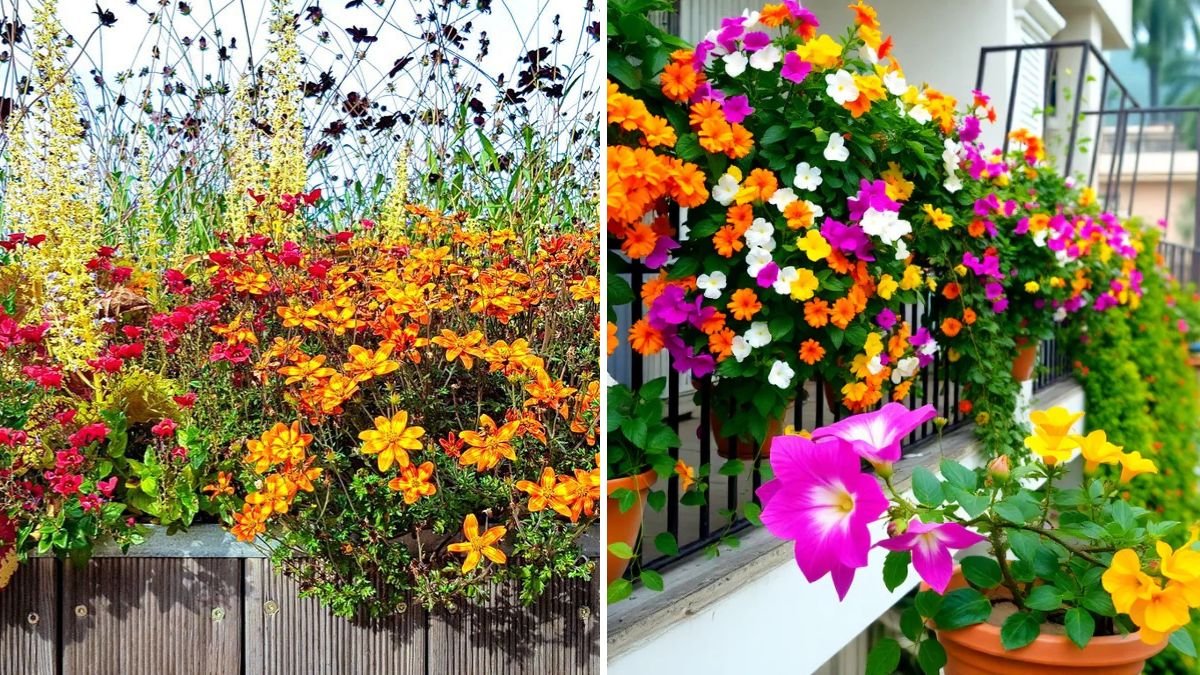Balconies are more than just small outdoor spaces—they are extensions of your home where you can relax, entertain, and enjoy nature. Adding flowers to your balcony instantly brings color, fragrance, and a cheerful ambiance. With the right selection of plants, even a small balcony can be transformed into a vibrant, inviting oasis.
This guide explores the best balcony flowers for instant charm, including planting tips, care instructions, sunlight requirements, and arrangement ideas to help you create a stunning, low-maintenance floral display.
1. Why Flowers Are Essential for Balcony Charm
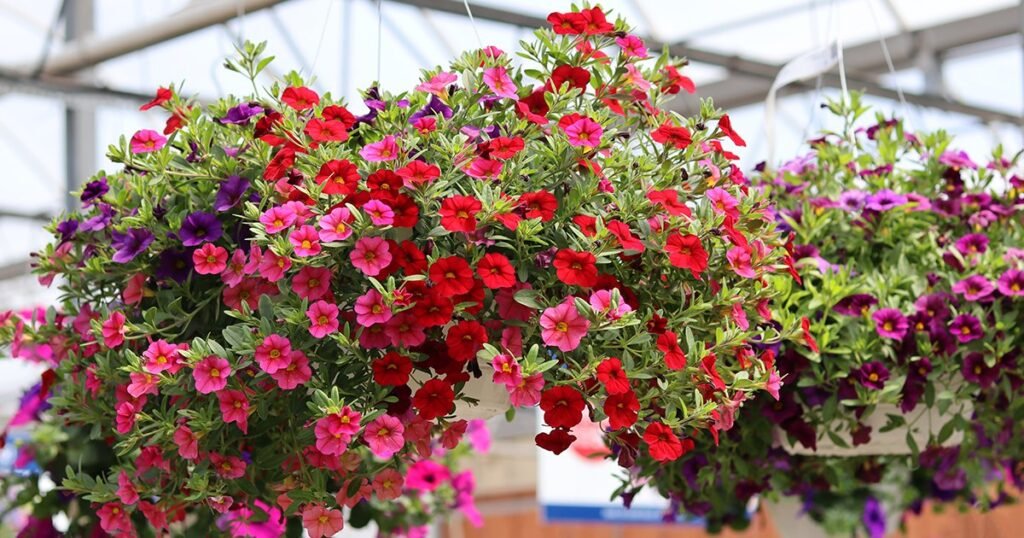
Balcony flowers offer more than visual appeal:
- Aesthetic Appeal: Colorful blooms brighten the space and make it feel welcoming.
- Mood Enhancement: Flowers reduce stress, improve mood, and create a calming environment.
- Air Quality: Many flowering plants release oxygen and help purify the air.
- Biodiversity: Attract pollinators like bees, butterflies, and birds, enhancing your balcony ecosystem.
Tip: Choose a mix of flowering plants and greenery for a balanced, layered look.
2. Choosing Flowers Based on Sunlight
Balconies vary in sunlight exposure, which determines the best flowers to grow:
- Full Sun (6–8 hours daily): Petunias, marigolds, geraniums, and zinnias thrive in direct sunlight.
- Partial Sun/Partial Shade (3–6 hours daily): Begonias, fuchsias, impatiens, and nasturtiums prefer filtered sunlight.
- Shade (Less than 3 hours daily): Hostas, coleus, and begonias flourish in low-light conditions.
Tip: Observe your balcony at different times of day to determine sunlight patterns before selecting plants.
3. Best Balcony Flowers for Instant Charm
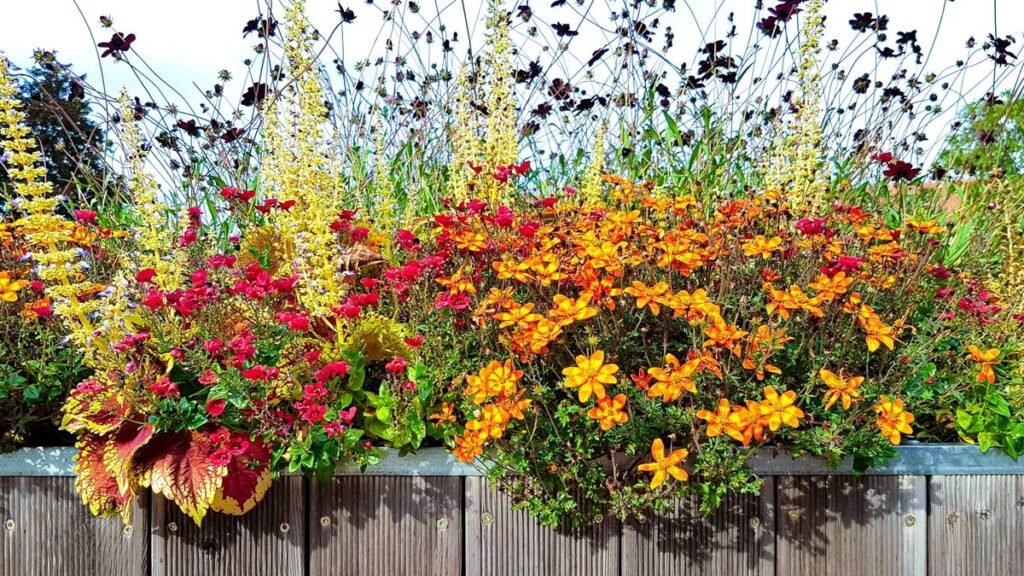
Here are top flower options that are easy to grow and instantly enhance your balcony:
a) Petunias
- Features: Vibrant, trumpet-shaped flowers in a variety of colors.
- Benefits: Long blooming season and easy maintenance.
- Care: Requires full sun, regular watering, and well-drained soil.
b) Marigolds
- Features: Bright yellow, orange, and gold flowers.
- Benefits: Adds cheerful color and repels certain pests naturally.
- Care: Prefers full sun and moderate watering; deadhead regularly to encourage blooms.
c) Geraniums
- Features: Rounded clusters of bright red, pink, or white flowers.
- Benefits: Compact and ideal for pots or hanging baskets.
- Care: Requires 4–6 hours of sunlight, well-draining soil, and occasional fertilization.
d) Petites Impatiens
- Features: Shade-loving flowers in pink, red, white, and purple.
- Benefits: Perfect for balconies with minimal sunlight.
- Care: Keep soil consistently moist and protect from strong winds.
e) Fuchsias
- Features: Pendulous, bell-shaped flowers in vivid colors.
- Benefits: Adds elegance and attracts hummingbirds or butterflies.
- Care: Thrives in partial shade; regular watering and misting improve growth.
f) Nasturtiums
- Features: Bright orange, yellow, and red edible flowers.
- Benefits: Adds charm and culinary uses; deters pests naturally.
- Care: Prefers full sun to partial shade and well-drained soil.
g) Bougainvillea (Dwarf Varieties)
- Features: Bright magenta, pink, or purple blooms; ideal for balcony walls.
- Benefits: Provides long-lasting color and climber-friendly growth.
- Care: Needs full sun and moderate watering; prune to maintain shape.
h) Pansies
- Features: Colorful, multi-hued flowers with unique “faces.”
- Benefits: Bloom in cooler months, adding charm year-round.
- Care: Prefers partial sun; water regularly and protect from extreme heat.
4. Container and Pot Selection
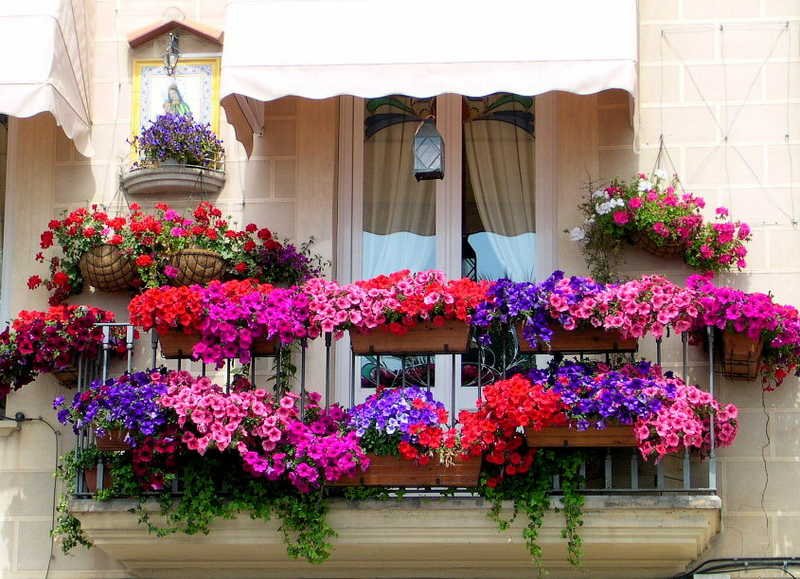
Flowers in the right containers look attractive and grow healthier:
- Material: Terra-cotta for breathability, plastic for lightweight mobility, ceramic for decorative appeal.
- Size: Ensure pots are large enough for roots; most flowers need 8–12 inch pots.
- Drainage: Drill holes in the bottom to prevent waterlogging.
- Grouping: Combine flowers in clusters or use vertical arrangements for compact balconies.
Tip: Use hanging baskets, railing planters, or tiered stands to maximize space and visual impact.
5. Soil and Fertilization
Healthy flowers depend on well-prepared soil and proper nutrients:
- Soil Mix: Use potting soil enriched with compost for nutrient retention.
- Drainage: Add sand, perlite, or small stones to improve drainage.
- Fertilization: Use a balanced liquid fertilizer every 2–3 weeks during the growing season.
- Organic Options: Compost tea or seaweed extract promotes vibrant blooms naturally.
Tip: Avoid garden soil alone; it may compact in pots and restrict root growth.
6. Watering Techniques
Proper watering ensures vibrant flowers and long-lasting blooms:
- Frequency: Check soil moisture daily; water when the top inch feels dry.
- Method: Water at the base to avoid wetting leaves and flowers, reducing disease risk.
- Mulching: Apply mulch to retain moisture, regulate temperature, and reduce evaporation.
Tip: Container flowers dry out faster than garden beds, especially in sunny or windy balconies.
7. Pruning and Deadheading
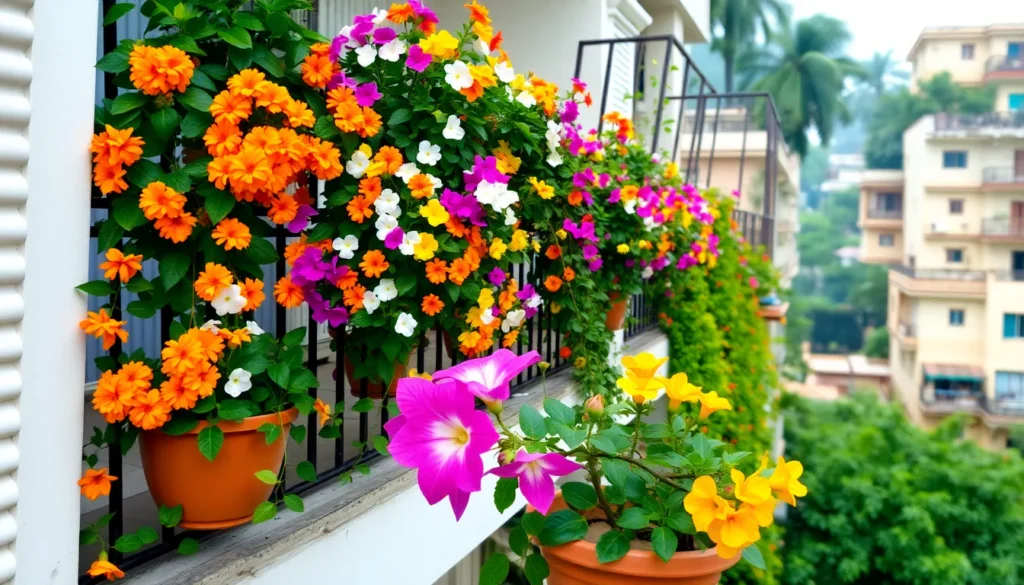
Regular pruning maintains plant health and encourages continuous flowering:
- Deadheading: Remove faded flowers to promote new blooms.
- Pruning: Trim overgrown stems to maintain shape and prevent overcrowding.
- Leaf Care: Remove yellow or damaged leaves to enhance overall appearance.
Tip: Regular maintenance keeps your balcony flowers looking fresh and attractive throughout the season.
8. Seasonal Considerations
Flowers need seasonal care to maintain charm:
- Spring/Summer: Most balcony flowers thrive; increase watering and fertilization.
- Autumn/Winter: Choose cold-hardy flowers like pansies or cyclamen; reduce watering.
- Rain Protection: Move containers to sheltered areas during heavy rainfall.
- Sun Protection: Provide shade during extreme summer heat to prevent leaf scorch.
Tip: Rotating containers with the seasons keeps your balcony vibrant year-round.
9. Companion Planting for Added Appeal
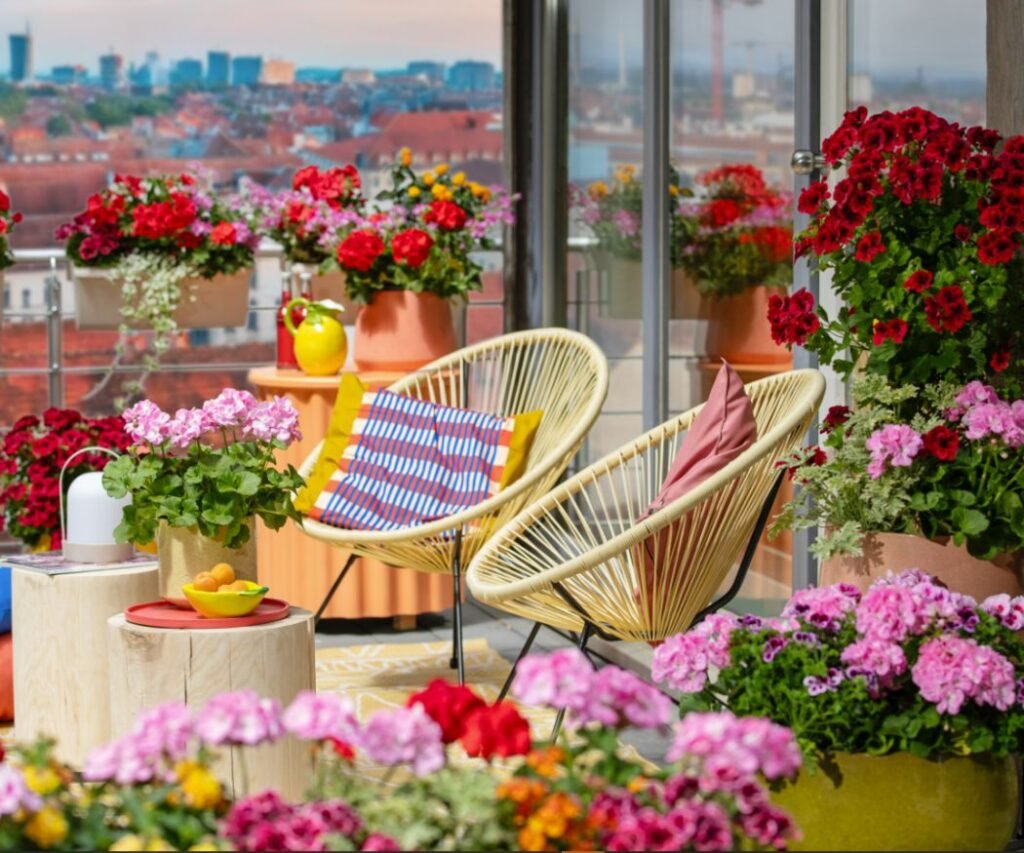
Mixing flowers with herbs or foliage plants enhances aesthetic appeal and functionality:
- Aesthetic Mix: Combine bright flowers with trailing greenery like ivy or creeping thyme.
- Functional Mix: Plant basil, mint, or marigolds near flowers to deter pests naturally.
- Color Harmony: Use complementary colors (yellow with purple, red with white) for a visually stunning effect.
Tip: Group pots of varying heights and sizes to create layers and visual depth on your balcony.
10. Additional Tips for Balcony Flower Charm
- Hanging Baskets: Ideal for trailing flowers like fuchsias or nasturtiums.
- Rail Planters: Maximize space along balcony edges.
- Vertical Gardens: Use wall-mounted planters for climbing flowers like dwarf bougainvillea.
- Decorative Touches: Use colorful pots, fairy lights, or garden ornaments for extra charm.
- Regular Rotation: Rotate pots for even sunlight exposure and symmetrical growth.
Conclusion
Choosing the right flowers for your balcony can instantly transform your space into a vibrant, colorful, and inviting retreat. By selecting plants based on sunlight, container size, and maintenance requirements, even small balconies can achieve maximum charm with minimal effort.
Key takeaways:
- Assess sunlight exposure and choose suitable flowers.
- Use well-draining, nutrient-rich soil and appropriately sized containers.
- Water consistently, using mulch to retain moisture.
- Fertilize regularly to encourage vibrant blooms.
- Prune and deadhead flowers to maintain freshness.
- Incorporate vertical gardening and hanging baskets for space efficiency.
- Mix flowering and foliage plants for color, texture, and visual depth.
- Adapt seasonal care to maintain blooms year-round.
- Add decorative touches to enhance balcony aesthetics.
- Regular maintenance ensures a long-lasting, charming display.
With thoughtful planning and care, balcony flowers can create an instant visual impact, uplift your mood, and make your outdoor space truly enchanting.
